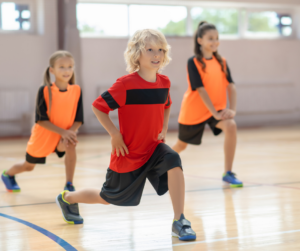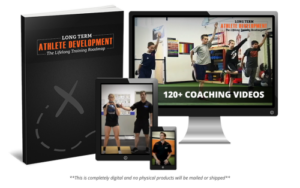 Athletic development across the lifespan is a complex process that is heavily influenced by the cognitive and physical maturity of the individual. Unfortunately, conditioning and fitness programming for the developing athlete have most often been designed around routines initially intended for adult and elite level athletes.
Athletic development across the lifespan is a complex process that is heavily influenced by the cognitive and physical maturity of the individual. Unfortunately, conditioning and fitness programming for the developing athlete have most often been designed around routines initially intended for adult and elite level athletes.
This is NOT appropriate or effective and can set kids up for failure. It can also put the young athlete at risk for acute and chronic injury.
By understanding the process of motor development, the coach or youth fitness professional will be far better equipped to create long-term programs that are developmentally appropriate every step of the way. This will only optimize the experience of the young athlete in the game and beyond the game.
Physical literacy is the goal and the cornerstone of basic human movement and fundamental movement skills. It is described as motivation, confidence, physical competence, knowledge, and understanding to value and engage in a physically active lifestyle (1. Longmuir C, Boyer C et al.)
The youth fitness professional, parents and sport coaches must apply the concepts of physical literacy in order to ensure that the child may have the best opportunity to develop and achieve success in movement, sport, and life.
This needs to be a combined effort from coaches, trainers, parents/guardians, and children.
 Developing the fundamental movement skills (e.g., walking, running, and jumping) happens early on in a child’s life. Unfortunately, being unable to perform fundamental movement skills can restrict later opportunities, which is why it is vital to develop physical literacy early in the child’s life.
Developing the fundamental movement skills (e.g., walking, running, and jumping) happens early on in a child’s life. Unfortunately, being unable to perform fundamental movement skills can restrict later opportunities, which is why it is vital to develop physical literacy early in the child’s life.
As coaches, if we hope to create great athletes who have a chance at being successful for the long haul, then your programs must be based on Long Term Athletic Development.
Just like a baby must learn to roll over before crawling, crawl before standing, stand before walking, and walk before running, your athletes need to build a foundation for elite level athletic performance before they can reach their maximum potential.
When athletes specialize early and skip critical steps in building this foundation, they are at extreme risk for injury and burnout. The trouble is, building that foundation early isn’t always sexy. And often coaches may not understand the exact steps to building the foundation.
However, that’s not your fault! Many are inundated with ‘influence’ of non-experts in this area and it’s at a detriment to our kids.
When it comes down to it, you and the athletes want results, and you’ve been told that specialization is the way to do it. Unfortunately this is wrong and setting our athletes up for failure, in their game and beyond their game.
But the trends are shifting, and it’s time to get back on the path towards Physical Literacy and Long Term Athlete Development for EVERY athlete!
 The very first step in any effort towards change, is to gain education. Our Long Term Athlete Development Roadmap is the perfect place to start or enhance your current knowledge.
The very first step in any effort towards change, is to gain education. Our Long Term Athlete Development Roadmap is the perfect place to start or enhance your current knowledge.
Will you join the mission with us?
We cannot do this alone and we need other parents, trainers, school administration, sport coaches and professionals to stand up for Long Term Athlete Development and Physical Literacy.
It’s time to move. Our athletes’ will thank us!
We’d love to hear from you, don’t hesitate to share your thoughts in the comments!
References:
1. Longmuir C, Boyer C, Lloyd M, Yang Y, Boiarskaia E, Zhu W, Tremblay M. The Canadian Assessment of Physical Literacy: methods for children in grades 4 to 6 (8-12 years). http://www.ncbi.nlm.nih.gov/pmc/articles/PMC4532252/#CR1
2. Gleason, D, Brooks, T, Fleming, W. Long Term Athlete Development: The Lifelong Training Roadmap. https://iyca.org/ltad/

